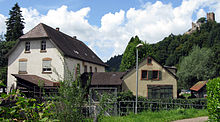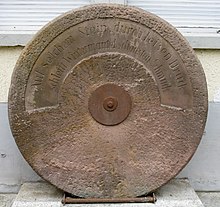Winter coat (gemstone cutting)
The company August winter coat is a gemstone in Waldkirch in Breisgau . It is the last remaining representative of an important handicraft tradition in the region, the roots of which are significantly older than the manufacture of clocks or the construction of organs and jukeboxes for which the place is known today.
history
The gemstone in the region is for Freiburg is the first time in 1368, in Waldkirch from 1467. This year was the place the St. Anne - Brotherhood as a guild of "drill and Balierer". In addition to the stone deposits, which were relatively modest, the reason for the settlement of the industry was probably the available hydropower. The Waldkirch grinding shops settled on the commercial canal that runs near the Elz .
Initially, the cutters obtained their rough stones from the silver, copper and lead mines in Freiamt , Simonswald and in Suggental . Since there are no significant sites for gemstones in the Black Forest , mining soon came to a standstill. After that, the grinding shops usually obtained their material from outside ( rock crystals from the Gotthard massif , later agates and jasper from Idar-Oberstein , probably from 1526 garnets from Bohemia ), processed the material and re-exported the finished products.
According to a privilege granted by King Rudolf II , Bohemian stones were only allowed to be cut in Waldkirch and Freiburg for a long time. At the end of the 16th century the craft reached its first heyday. In Waldkirch, which at that time had 900 inhabitants, more than 40 master grinders are said to have resided, at times practically the entire place is said to have been employed in the grinding trade. This brought the church to prosperity. During the plague there was a brief economic slump, but the Thirty Years' War and many that followed in the 17th century led to a permanent decline.
Supported by the Habsburg Empress Maria Theresa , garnet grinding began to flourish again from the middle of the 18th century, which lasted until around 1770. During this time there were 28 grinding shops with over 400 employees.
However, the growing supraregional competition meant that by 1800 the grinding trade in the region had almost completely died out. In Waldkirch alone, only a few companies survived for some time. In 1813 there were only two companies left here: the Trenkle brothers, which last moved from Waldkirch to Freiburg and gave up in the 1820s despite support measures, and the August Wintermantel company founded in 1825.
The jewelery shop August Wintermantel, now owned by Bernhard Wintermantel, operates, in addition to its current premises in the former company buildings , the grinding shop, which is now a listed building , and is one of the largest and oldest artisanal gemstone cutting shops in Germany that has been preserved in the original and is still in operation. It is therefore not always open, but guided tours are offered on a regular basis.
literature
- Fritz Jörger (author), Bernhard Wintermantel, Andreas Haasis-Berner (arr.): Die Bohrer und Balierer in Breisgau, once seen from Waldkirch: written 1944/45 / Fritz Jörger. Published posthumously and supplemented with images by August Wintermantel and Bernhard Wintermantel . Waldkirch: Self-published Wintermantel 2004, ISBN 3-00-014405-6
Web links
- For the history of the gemstone cutters in Waldkirch , page of the city of Waldkirch
- Gemstone cutting on the commercial canal in Waldkirch , side of the city of Waldkirch
Coordinates: 48 ° 5 '46.4 " N , 7 ° 57' 47.4" E

